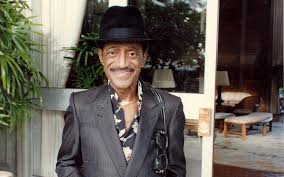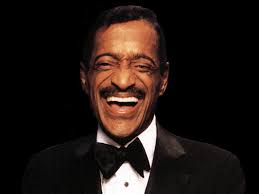 SAMMY DAVIS JR., UN DESCENDIENTE CUBANO, DESTACADO ARTISTA, NUNCA OLVIDADO. VIDEOS.
SAMMY DAVIS JR., UN DESCENDIENTE CUBANO, DESTACADO ARTISTA, NUNCA OLVIDADO. VIDEOS.
Samuel George “Sammy” Davis, Jr. nació en la sección de Harlem de Manhattan en la ciudad de Nueva York el 8 de diciembre de 1925, como hijo único de Sammy Davis, Sr., un artista negro, y Elvira Sánchez, una afrocubana de tap. bailarina, cuya madre nació en La Habana, Cuba. Fue un artista estadounidense, principalmente bailarín y cantante, también fue actor de teatro y pantalla, músico e impresionista conocido por sus imitaciones de actores, músicos y otras celebridades.
En su biografía de 2003 En blanco y negro, el autor Wil Haygood escribe que la madre de Davis, Jr. nació en la ciudad de Nueva York, es una madre afrocubana y un padre afroamericano y que Davis, Jr. afirmó que era puertorriqueño porque Temía que la reacción anticubana perjudicara sus ventas récord.
A la edad de tres años Davis comenzó su carrera en el vodevil con su padre y Will Mastin como Will Mastin Trio, que realizó una gira a nivel nacional. Después del servicio militar, Davis regresó al trío. Davis se convirtió en una sensación de la noche a la mañana después de una actuación en un club nocturno en Ciro’s (en West Hollywood, California) después de los Premios de la Academia de 1951. Con el trío, se convirtió en artista de grabación.
Durante la Segunda Guerra Mundial, Davis fue reclutado por el Ejército de los Estados Unidos en 1943 a la edad de 18 años.
Después de su baja, Davis se reincorporó al grupo de baile familiar, que se realizaba en clubes de Portland, Oregon. También grabó canciones de blues para Capitol Records en 1949, bajo los seudónimos de Shorty Muggins y Charlie Green.
https://youtu.be/xz-pzg-b7DI
El 23 de marzo de 1951, actuando con “Will Mastin Trio” apareció en Ciro’s como el acto de apertura de la cabeza de cartel Janis Paige. Iban a actuar durante solo 20 minutos, pero la reacción de la multitud llena de celebridades fue tan entusiasta, especialmente cuando Davis se lanzó a sus impresiones, que actuaron durante casi una hora, y Paige insistió en que se cambiara el orden del espectáculo. Davis comenzó a lograr el éxito por su cuenta y fue elogiado por los críticos, lanzando varios álbumes.
En 1953, le ofrecieron a Davis su propio programa de televisión en ABC, Three for the Road, con Will Mastin Trio. La cadena gastó $ 20,000 en filmar el piloto, que presentaba a los afroamericanos como músicos en apuros, no como una comedia de payasadas o los papeles estereotipados de mamita de la época.
En 1954, Davis fue contratado para cantar la canción principal de la película de Universal Pictures Six Bridges to Cross. En 1956, protagonizó el musical de Broadway Mr. Wonderful.
En 1954, perdió el ojo izquierdo en un accidente automovilístico en San Bernardino, California, mientras realizaba un viaje de regreso de Las Vegas a Los Ángeles. Durante el año anterior, había entablado una amistad con el comediante y presentador Eddie Cantor, quien le había regalado una mezuzá. En lugar de ponerlo junto a su puerta como una bendición tradicional, Davis lo usó alrededor de su cuello para tener buena suerte.
El accidente ocurrió en una bifurcación en la Ruta 66 de los EE. UU. En Cajon Boulevard y Kendall Drive. Davis perdió su ojo izquierdo por el botón de la bocina en forma de bala (una característica estándar en los Cadillacs de 1954 y 1955) como resultado. Su amigo, el actor Jeff Chandler, dijo que le daría uno de sus propios ojos si eso evitaba que Davis se quedara totalmente ciego. Davis usó un parche en el ojo durante al menos seis meses después del accidente. Apareció con el parche en la portada de su álbum debut y apareció en What’s My Line? usando el parche. Más tarde, le colocaron un ojo de cristal, que usó durante el resto de su vida.
Davis era un gran fanático de la televisión diurna, en particular las telenovelas producidas por la American Broadcasting Company. Hizo un cameo en ‘General Hospital’ y tuvo un papel recurrente como Chip Warren en ‘One Life to Live’, por la que recibió una nominación al premio Emmy diurno de 1980. También era un fanático de los programas de juegos, apareciendo en ‘Family Feud’ en 1979 y ‘Tattletales’ con su esposa Altovise en la década de 1970.
Después de su ataque de cirrosis debido a años de beber, Davis anunció su patrocinio del Instituto Nacional del Hígado Sammy Davis Jr. en Newark, Nueva Jersey en 1985. En 1988, Davis fue facturado para una gira con Frank Sinatra y Dean Martin, pero Sinatra y Martin tuvo una pelea. Liza Minnelli reemplazó a Dean en la gira denominada “The Ultimate Event”. Durante la gira en 1989, Davis fue diagnosticado con cáncer de garganta; sus tratamientos le impidieron actuar.
Su amigo Eddie Cantor habló con Davis en el hospital sobre las similitudes entre las culturas judía y negra. Davis, quien nació de madre católica y padre bautista, comenzó a estudiar la historia de los judíos. Se convirtió al judaísmo varios años más tarde en 1961. Un pasaje de sus lecturas (del libro Una historia de los judíos de Abram L. Sachar), que describe la resistencia del pueblo judío, le interesó en particular: “Los judíos no morirían . Tres milenios de enseñanza profética les habían dado un espíritu inquebrantable de resignación y habían creado en ellos una voluntad de vivir que ningún desastre podría aplastar “. El accidente marcó un punto de inflexión en la carrera de Davis, que lo llevó de un artista conocido a una celebridad nacional.
Davis murió de complicaciones de cáncer de garganta en su casa en Beverly Hills, California, el 16 de mayo de 1990, a la edad de 64 años. Fue enterrado en Forest Lawn Memorial Park en Glendale, California. El 18 de mayo de 1990, dos días después de su muerte, las luces de neón del Strip de Las Vegas se oscurecieron durante 10 minutos como homenaje.
 SAMMY DAVIS JR., A CUBAN DESCENDANT OUTSTANDING ARTIST NEVER FORGOTTEN. VIDEOS.
SAMMY DAVIS JR., A CUBAN DESCENDANT OUTSTANDING ARTIST NEVER FORGOTTEN. VIDEOS.
Samuel George “Sammy” Davis, Jr. was born in the Harlem section of Manhattan in New York City on December 8, 1925, as the only child to Sammy Davis, Sr. a black entertainer, and Elvira Sanchez, a tap Afro-Cuban dancer, whose mother was born in Havana, Cuba. He was an American entertainer, primarily a dancer and singer, he was also an actor of stage and screen, musician, and impressionist noted for his impersonations of actors, musicians, and other celebrities.
In his 2003 biography In Black and White, author Wil Haygood writes that Davis, Jr.’s mother was born in New York City, Afro-Cuban mother and an African-American father and that Davis, Jr. claimed he was Puerto Rican because he feared anti-Cuban backlash would hurt his record sales.
https://youtu.be/rbLlCxK0pHY
At the age of three Davis began his career in vaudeville with his father and Will Mastin as the Will Mastin Trio, which toured nationally. After military service, Davis returned to the trio. Davis became an overnight sensation following a nightclub performance at Ciro’s (in West Hollywood, California) after the 1951 Academy Awards. With the trio, he became a recording artist.
During World War II, Davis was drafted into the U.S. Army in 1943 aged 18.
After his discharge, Davis rejoined the family dance act, which played at clubs around Portland, Oregon. He also recorded blues songs for Capitol Records in 1949, under the pseudonyms Shorty Muggins and Charlie Green.
On March 23, 1951, acting with “the Will Mastin Trio” appeared at Ciro’s as the opening act for headliner Janis Paige. They were to perform for only 20 minutes but the reaction from the celebrity-filled crowd was so enthusiastic, especially when Davis launched into his impressions, that they performed for nearly an hour, and Paige insisted the order of the show be flipped. Davis began to achieve success on his own and was singled out for praise by critics, releasing several albums.
In 1953, Davis was offered his own television show on ABC, Three for the Road—with the Will Mastin Trio. The network spent $20,000 filming the pilot, which presented African Americans as struggling musicians, not slapstick comedy or the stereotypical mammy roles of the time.
In 1954, Davis was hired to sing the title song for the Universal Pictures film Six Bridges to Cross. In 1956, he starred in the Broadway musical Mr. Wonderful.
In 1954, he lost his left eye in an automobile accident in San Bernardino, California, as he was making a return trip from Las Vegas to Los Angeles. During the previous year, he had started a friendship with comedian and host Eddie Cantor, who had given him a mezuzah. Instead of putting it by his door as a traditional blessing, Davis wore it around his neck for good luck.
The accident occurred at a fork in U.S. Route 66 at Cajon Boulevard and Kendall Drive. Davis lost his left eye to the bullet-shaped horn button (a standard feature in 1954 and 1955 Cadillacs) as a result. His friend, actor Jeff Chandler, said he would give one of his own eyes if it would keep Davis from total blindness. Davis wore an eye patch for at least six months following the accident. He was featured with the patch on the cover of his debut album and appeared on What’s My Line? wearing the patch. Later, he was fitted for a glass eye, which he wore for the rest of his life.
Davis was a huge fan of daytime television, particularly the soap operas produced by the American Broadcasting Company. He made a cameo appearance on ‘General Hospital’ and had a recurring role as Chip Warren on ‘One Life to Live’, for which he received a 1980 Daytime Emmy Award nomination. He was also a game show fan, appearing on ‘Family Feud’ in 1979 and ‘Tattletales’ with his wife Altovise in the 1970s.
After his bout with cirrhosis due to years of drinking, Davis announced his sponsorship of the Sammy Davis Jr. National Liver Institute in Newark, New Jersey in 1985. In 1988, Davis was billed to tour with Frank Sinatra and Dean Martin, but Sinatra and Martin had a falling out. Liza Minnelli replaced Dean on the tour dubbed as ”The Ultimate Event.” During the tour in 1989, Davis was diagnosed with throat cancer; his treatments prevented him from performing.
His friend Eddie Cantor talked to Davis in the hospital about the similarities between Jewish and Black cultures. Davis, who was born to a Catholic mother and Baptist father, began studying the history of Jews. He converted to Judaism several years later in 1961. One passage from his readings (from the book A History of the Jews by Abram L. Sachar), describing the endurance of the Jewish people, interested him in particular: “The Jews would not die. Three millennia of prophetic teaching had given them an unwavering spirit of resignation and had created in them a will to live which no disaster could crush.” The accident marked a turning point in Davis’s career, taking him from a well-known entertainer to a national celebrity.
Davis died of complications from throat cancer in his home in Beverly Hills, California, on May 16, 1990, aged 64. He was interred in Forest Lawn Memorial Park in Glendale, California. On May 18, 1990, two days after his death, the neon lights of the Las Vegas Strip were darkened for 10 minutes as a tribute.
Agencies/ Wiki/ Various/ Internet Photos/ YouTube/ Arnoldo Varona/ www.TheCubanHistory.com
THE CUBAN HISTORY, HOLLYWOOD.



 SAMMY DAVIS Jr., un Descendiente Cubano, destacado Artista, Nunca Olvidado. VIDEOS.
SAMMY DAVIS Jr., un Descendiente Cubano, destacado Artista, Nunca Olvidado. VIDEOS.





